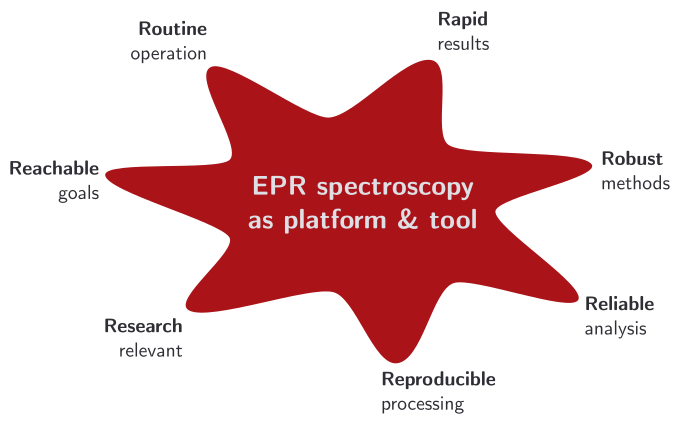EPR spectroscopy for the 21st century
EPR spectroscopy is the method of choice for a number of urgent and highly relevant research questions, including new materials and power conversion techniques. However, contrary to its sibling NMR, EPR spectroscopy has never gained the attention and maturity to allow for routine application. Have a look at problems and their reasons.
The idea and declared goal of this project is to establish EPR spectroscopy as platform and tool for routine analysis as well as robust, reliable, and reproducible fundamental research in many areas, with a particular focus on energy materials and organic electronics. An outline of the aspects of this vision is given in the figure below.

The Vision: Establishing EPR spectroscopy as a platform and tool to routinely investigate state-of-the-art scientific questions of high relevance. The “seven R’s” will be detailed in the corresponding section.
The good news is: the tools necessary are (mostly) available. They only need to be connected the right way. The bad news is: we’re not there yet. Somebody has to take the burden and lay out and follow the agenda to convert EPR spectroscopy into an open platform to achieve these goals. Have a look at the tools available and under development.
Keep it simple – and get the most out of it
Many EPR spectroscopists consider pulsed EPR spectroscopy with pulse shaping, high frequency, and possibly rapid-scan technology as the driving forces behind further method development. Surely, each of these aspects have their merits and are worth considering, and the brightest heads of the field are working to make them a real success.
However, it is the express view of the author of this project that none of these will help making EPR spectroscopy more attractive for broad and routine application in fundamental research. Quite the opposite is true: Focussing on X-band cw-EPR spectroscopy at (mostly) room temperature, but greatly facilitating data acquisition and enhancing data analysis prevents many of the current pitfalls, such as being too expensive, too slow, too complicated, and too unreliable. On the other hand, this allows to develop EPR spectroscopy further into an open platform to incorporate other techniques, such as electrochemistry or optical spectroscopy, in situ.
An open and collaborative platform
To make EPR spectroscopy fit for the 21st century can only be achieved in a highly collaborative and interdisciplinary fashion, including both, scientists and industry. Probably the biggest responsibility of EPR hardware vendors is to maintain their current APIs allowing to access the devices by third-party software in a modular fashion and to integrate other tools. Most other aspects are within the responsibility of scientists, joining forces and working truly interdisciplinary to achieve the goals set out in the vision, particularly the “seven R’s”.
Learning to ask the right questions
Probably the most important skill of scientists is to develop a feeling for asking the right questions. This requires a thorough and deep understanding of their respective field and state-of-the-art knowledge. Asking the right questions as well implies to get a step beyond what is known and has been done, but based on a solid understanding and knowledge of what is readily available and what ought to be possible with minimal effort. Additionally, asking questions requires the scientists to have ample time to think about their data and projects. Hence, automating whatever is sensibly possible is the order of the day.
In this sense, the right question to ask is not “How can we make more people use EPR spectroscopy”. Developing EPR spectroscopy into a platform and tool for routine application is not an end in itself. Instead, think of the big questions of your research area and ask yourself: How could EPR spectroscopy help addressing these questions and obtain information (and possibly answers) other methods can not contribute? The author’s field of research is organic electronics. Have a look at his ideas for applications of EPR spectroscopy.